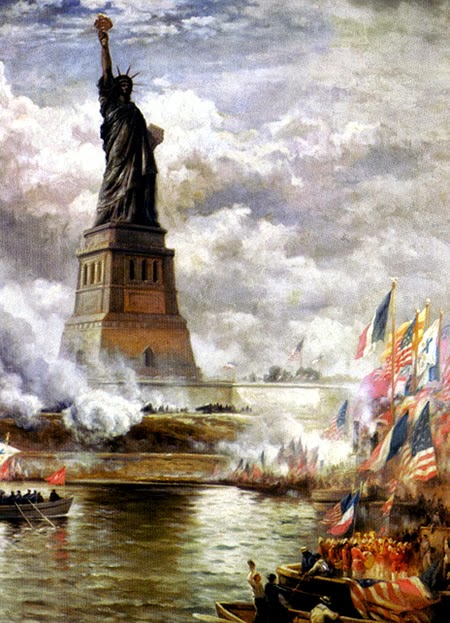 |
| Statue of Liberty |
Since its 1886 installation in New York Harbor, where it was then the tallest structure, this 305-foot, 225-ton copper-clad statue of a stern-faced woman whose torch “Enlightens the World,” has become one of the world’s best-known symbols, as well as one of its more contentious.
The idea of recognizing French-American friendship as the U.S. centennial neared was conceived in 1865 by French jurist Edouard-René Lefebvre de Laboulaye, a longtime admirer of American freedom and foe of Napoleon III’s Second Empire. Dining with Laboulaye, Alsatian sculptor Frédéric-Auguste Bartholdi, already known for his monumental works, suggested a statue of heroic size to be situated in New York City.
The United States would be 110 years old before Bartholdi’s immense figure, supported by an iron skeleton designed by French engineer Gustav Eiffel
  |
Poet Emma Lazarus
Of course, it was not so simple. The gala unveiling on October 28, 1886, occurred just five months after Haymarket, a Chicago labor protest that turned violent and led to the execution of seven immigrants presumed to be violent anarchists.
As President Cleveland spoke, women’s suffrage advocates protested the nearly all-male ceremony for the world’s largest female figure. That year, anarchist and birth control proponent Emma Goldman admired the Statue of Liberty as a symbol of freedom as she arrived in New York from Lithuania. In 1919 she would view the “Mother of Exiles” a final time as she was deported to the Soviet Union during a Red Scare.
In recent years the Statue of Liberty has continued to be a major tourist destination, despite security and structural issues that have limited trips to what is now Liberty Island and exploration of the monument itself. For Liberty’s 1986 centennial, a huge fund-raising drive, headed by major corporations, collected some $230 million to refurbish the statue and nearby Ellis Island, where, after 1892, newly arriving immigrants were processed in Liberty’s shadow.
Meanwhile, the statue’s rich symbolism continues to inspire humor and protest: advocacy of open immigration and celebration of the republican ideals of liberty that infused both the American Revolution and the French Revolution. In 1989 a 30-foot-high styrofoam figure modeled on the Statue of Liberty was created by Tiananmen Square pro-democracy protesters. It stood for five days before it was crushed by a Chinese government tank.